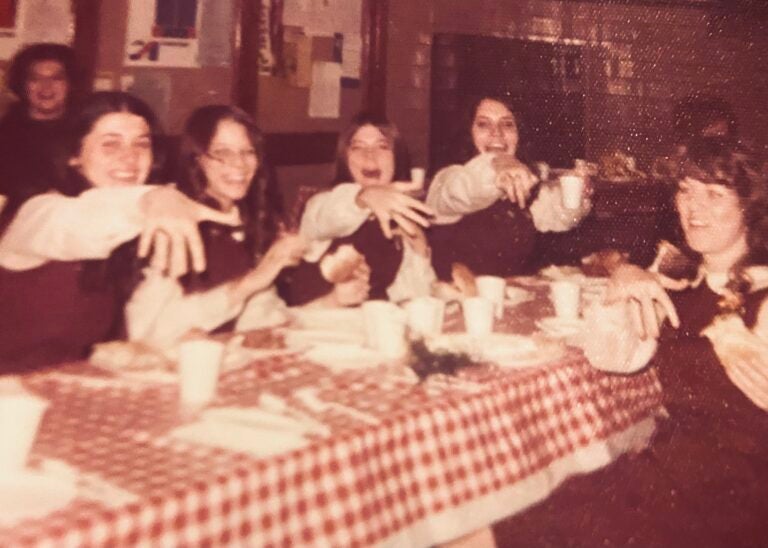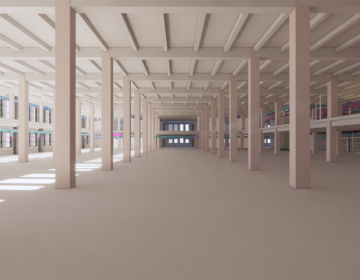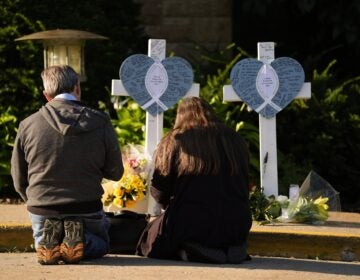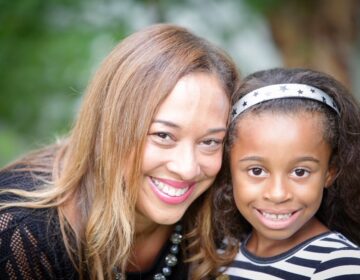Empowering women through education that empowers girls
The lessons I learned at my all-girls high school are things every young woman should know: Be confident in who you are. Envision your dreams and try to achieve them.

Joanne McLaughlin (at right, back row) and some classmates at a long-ago Ring Day celebration at Little Flower Catholic High School for Girls. (Courtesy of Joanne McLaughlin)
When the Archdiocese of Philadelphia announced in November that Bishop McDevitt and John W. Hallahan high schools would be closing at the end of this academic year, it felt personal. My daughter-in-law went to McDevitt, that was one reason.
Yet it was the news about Hallahan, the first all-girls Catholic high school in the United States, that really rocked me — and not because I’m an alumna of the school (I’m not), or because I know many women who went there. It’s because another pillar of single-sex secondary education for girls was about to fall.
That’s a loss I feel deeply. The lessons I learned at my all-girls high school are things every young woman should know: Be confident in who you are. Take a chance, envision your dreams, and try to achieve them.
I am a child of Oxford Circle. I was born into a multigenerational household started by immigrants, the second American generation in a Northeast Philly rowhouse where English was not always the preferred language. No one in my immediate family had gone to college at that point; some had not finished high school. In that way, I was like many young women in and around Philadelphia today, though I certainly don’t presume to think that their lives are in any way as easy as my white upbringing was.
In those days, the parish you belonged to determined which high school you attended after eighth grade. Girls in my parish went to Little Flower in Hunting Park, which opened in 1939 as Hallahan’s second so-called annex, a monument of sorts to its success. So off I went, taking three buses each way every day for four years, wearing the maroon uniform that marked me as one of about 2,000 students who walked through the always-gleaming brass doors at 10th and Lycoming streets.
There, my world widened. I met girls from all over Northeast and North Philadelphia, from Frankford and Kensington and Feltonville and Juniata and Logan. Girls like me but not, whose fathers, like mine, worked with their hands; whose mothers, like mine — Little Flower Class of 1946 — started out in secretarial jobs. African American girls and Latinas. (I also took classes in classical Latin that took me to competitions on the Main Line, with girls who attended private single-sex schools like Baldwin and Agnes Irwin. Again, girls like me, but not.)
For four years, we got to be who we were. Glamorous or not, as we chose — even in maroon jumpers, brown knee socks and ugly brown and tan saddle shoes, self-expression was a thing. Athletic or artistic or not, as we chose. Leaders if we wanted to be. The possibilities were ours to embrace or reject.
I’ll admit, going to college was a shock: I had nothing to wear and felt ill-prepared for the science classes I hoped to take. I was not a big fan of Catholic school at that point. But, wardrobe issues aside, I quickly realized how empowering going to a girls-only school had been. I was not shy about speaking my mind, not reluctant to show I was smart, and I fully expected to be represented in any decision that would affect my life. When it was clear that I was not going to cut it as a pre-med major, I fell back on journalism — the future career path I first set out on at Little Flower, where there was no boy to compete with for the top editor position on the school newspaper, and no male administrator to say I couldn’t have the job not once, but twice.
The Theresian’s faculty adviser was a Sister of the Immaculate Heart of Mary who was maybe 5 feet tall, but who made her presence and her high expectations known without a doubt. When, as a college junior, I had to write a mock obituary for an editorial-writing class, I chose her as a noteworthy figure whose life I would celebrate in print. The fact that I am still in the news business is a tribute to her.
At class reunions every five years, I learned more and more about the resilience Little Flower instilled in so many of us. Girls who had left to have children, or delayed college because of them, raised lovely families and worked hard at that career. Many went back to school and wrote new chapters afterward. Those of us who followed career paths first then had children got to show our baby pictures as others showed off their kids’ prom photos. Some chose not to marry; some chose to join religious orders. We went our own way, on our own terms, as far as we were able.
Some of us stay in touch; others are Facebook friends, but I love the connection, however socially distant. The alumnae association is always in touch — support from its graduates is what has kept Little Flower open. A few years ago, the school’s president called me at home, just to talk, not to ask for money, which I had already given. She thought it was important to let alums know we weren’t just checkbooks to her.
I hope that enduring women’s connection can continue at Little Flower — and especially now that John W. Hallahan Catholic High School for Girls won’t be around to offer the kind of life experience you just can’t get elsewhere.
When I graduated from Little Flower, this country was wrapping up a much-opposed foreign war and living under a polarizing presidency; Rev. Martin Luther King Jr.’s march on Washington had occurred 10 years earlier, but demands for racial justice were unrealized. Sounds all too familiar. The world we live in today demands strong women. Single-sex education may be just one way to ensure that we have them, but it’s a time-tested, often proven approach. I’d hate to see it die off.
Joanne McLaughlin is WHYY’s news editor for Health + Science/Suburbs.

Subscribe to PlanPhilly
WHYY is your source for fact-based, in-depth journalism and information. As a nonprofit organization, we rely on financial support from readers like you. Please give today.





